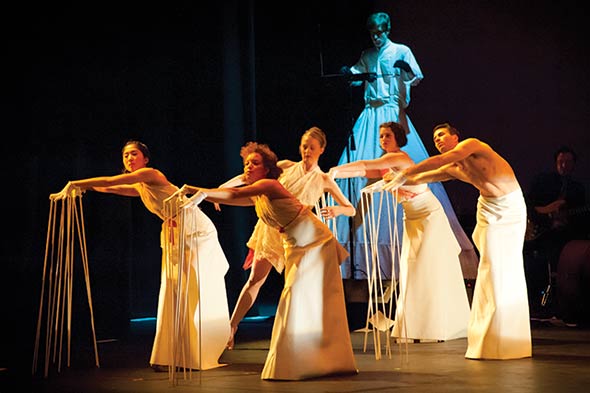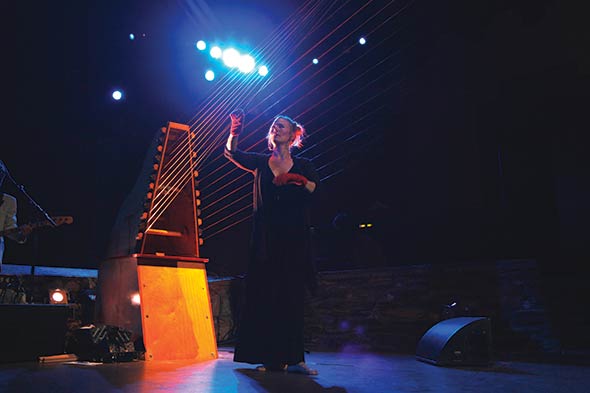

Like the physics theory after which it is named, String Theory, too, attempts to blend together two seemingly conflicting areas. While the former aims to harmonize quantum mechanics and relativity, the latter combines music, dance, and sculpture. This venture is such new territory that even String Theory co-founder, composer, instrument designer, and performer Luke Rothschild had some difficulty explaining precisely what it is that the group does and admitted that he’s “still working on the elevator pitch.” However, he did manage to summarize it as, “an amalgamation of performance elements that combine into a site-specific, immersive performance environment that is design-oriented.”
Using large musical and instrumental installations, Rothschild creates an environment that truly captivates the audience. Long strings and drums are physically integrated into the performance location and are played during the shows. His sculptures interact with the space not only sonically but also “physically and aurally.” He added that these concepts haven’t even truly touched the surface of what could be explored.
The idea for String Theory originally stemmed from Rothschild and his two friends, now choreographer/director Holly Rothschild and cellist/composer Joseph Harvey, who met from intersecting circles and began the ensemble as a unique mixture of music, choreography, and architecture. Rothschild explained that the name of the group came to light when he and his wife, Holly, attended Idea Festival in Lexington, Kentucky about 11 years ago. There, they attended a lecture conducted by Brian Greene, “relatively hip ambassador of the mathematical string theory to the public.” Holly, inspired by Greene’s mission to explain string theory to the masses and by his presentation involving the metaphor of string instruments (specifically the cello), proposed using the name to her husband.
While String Theory was born in Chicago (where the founding members studied), the group moved to LA to take advantage of the media hub. The group currently writes scores for television shows and films, creates music videos, and performs anywhere from concerts to corporate events. Often compared to Cirque du Soleil for its capacity and creative style, String Theory is still rather different, said Rothschild. Acrobatics aside, he agreed that both are “unique, visual, [with] bodies moving… and it’s sonic, a kind of experience that you don’t normally have.” However, String Theory does not quite adhere to Cirque’s model: a model that has talented directors using performers’ bodies merely as a means by which they can portray their work. Instead, String Theory allows the performers to choreograph, compose, etc. themselves. “There’s a lot more heart [in our work],” said Rothschild. He added that they don’t function on the same budget as Cirque, which forces String Theory performers to be more flexible and adaptive to their environments.
Additionally, Rothschild noted that his wife’s distinct choreography distinguishes String Theory from other modern dance groups: “Holly’s developed a vocabulary of movement to play [the string installations]… She brings in these really clear, specific, and resonant images throughout the show, [which] kind of pepper through, and they have a moment. And then it’s done. And then it’s eventually something else. It’s like a visual language of sonic vignettes that accompany the music and the sometimes projection.”
Rothschild mentioned that String Theory has also been compared to Blue Man Group for its affinity for audience interaction. While it’s not the main focus of their performances, they enjoy connecting with show-goers and often use humor to lighten the mood, said Rothschild. Like Greene, String Theory attempts to bring its modern performance style to the masses, transforming a potentially esoteric art into something more attainable. As String Theory grows, Rothschild anticipates it will extend past the country’s borders to explore a more global audience. Specifically, he hopes that the performances and installations will become culture-specific. While the group’s core currently consists of about eight people and 12-14 freelance performers, it is constantly expanding by “artistically” networking (via dance classes, etc.). Rothschild is optimistic for the future: “I see the group growing in the same direction as we have been, but just on a larger scale: doing even grander scale installations and performances in the US and internationally, working on higher profile feature films and collaborations with established directors and creatives.” stringtheoryproductions.com
TEXT BY Shilpika Lahri
PHOTOGRAPHY BY Christa Mae Photography(top photo)
and David Lowe (bottom photo)

